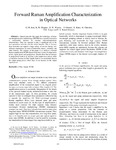Forward Raman Amplification Characterization in Optical Networks
| dc.contributor.author | Isoe, G.M | |
| dc.contributor.author | Muguro, K.M | |
| dc.contributor.author | Waswa, D.W | |
| dc.contributor.author | Osiemo, D. | |
| dc.contributor.author | Kirui, E | |
| dc.contributor.author | Cherutoi, H. | |
| dc.contributor.author | Boiyo, Kiboi | |
| dc.contributor.author | Rotich, E. | |
| dc.date.accessioned | 2019-09-11T07:04:27Z | |
| dc.date.available | 2019-09-11T07:04:27Z | |
| dc.date.issued | 2014 | |
| dc.identifier.issn | 2079-6226 | |
| dc.identifier.uri | http://ir.mksu.ac.ke/handle/123456780/4794 | |
| dc.description.abstract | Optical networks that apply the technology of dense wavelength-division multiplexing (DWDM) have recently resulted in a considerable increase in existing telecommunications infrastructures. They are expected to play a significant role in the next generation networks and the future Internet. This is because these networks can support a large variety of services having very different requirements in terms of bandwidth, latency, reliability and other features. The purpose of this paper is to analyze a forward Raman amplification WDM Optical Network in terms of output noise power, signal power and pump power. Results show that an increase in pump power leads to an increase in the output noise power, while a continuous increase in fibre lengths leads to an exponential drop in the output pump power which leads to an increase in the output signal power. | en_US |
| dc.language.iso | en_US | en_US |
| dc.subject | Fibre | en_US |
| dc.subject | Raman | en_US |
| dc.subject | WDM | en_US |
| dc.title | Forward Raman Amplification Characterization in Optical Networks | en_US |
| dc.type | Article | en_US |
Files in this item
This item appears in the following Collection(s)
-
School of Engineering and Technology [116]
Scholarly Articles by Faculty & Students in School of Engineering and Technology

